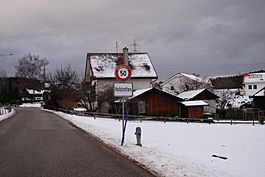Hofstetten, Zürich facts for kids
Quick facts for kids
Hofstetten
|
||
|---|---|---|
 |
||
|
||
| Country | Switzerland | |
| Canton | Zurich | |
| District | Winterthur | |
| Area | ||
| • Total | 8.85 km2 (3.42 sq mi) | |
| Elevation | 644 m (2,113 ft) | |
| Population
(December 2020)
|
||
| • Total | 500 | |
| • Density | 56/km2 (146/sq mi) | |
| Postal code |
8354
|
|
| Surrounded by | Aadorf (TG), Bichelsee-Balterswil (TG), Elgg, Elsau, Schlatt, Turbenthal | |
Hofstetten was once a small town, or municipality, in Switzerland. It was located in the canton of Zürich, which is like a state or region. Hofstetten was part of the Winterthur district.
On January 1, 2018, Hofstetten joined with the nearby town of Elgg. This means it is no longer a separate municipality.
Contents
A Look Back: Hofstetten's History
Hofstetten has a long history! It was first written about way back in the year 914. Back then, its name was Pipineshovestetin.
For a long time, until 2003, the town was known as Hofstetten bei Elgg. The "bei Elgg" part meant "near Elgg," which helped people know where it was.
Hofstetten's Landscape
Hofstetten covers an area of about 8.9 square kilometers (around 3.4 square miles). Imagine a square about 3 kilometers on each side – that's roughly its size!
Almost half of this land, about 49.9%, is used for farming. This means there are many fields where crops are grown or animals graze. Another large part, 45.8%, is covered by forests. These forests are home to many trees and wildlife.
A small portion, about 4.2%, has buildings and roads. The rest is made up of rivers or other natural areas.
Villages in Hofstetten
Hofstetten is nestled between a hill called the Schauenberg and the Eulach river valley. It's not just one big town. Instead, it's made up of several smaller villages.
These villages include Hofstetten itself, along with Huggenberg, Geretswil, Wenzikon, and Dickbuch. Each village has its own unique charm.
People of Hofstetten
As of the latest count, Hofstetten has a population of 500 people. Over the last ten years, the number of people living here has grown slightly.
Most people in Hofstetten speak German, which is the main language in this part of Switzerland. A small number of people also speak French or Italian.
Age Groups and Education
The people in Hofstetten are of all ages. About 30.3% of the population are children and teenagers (under 19 years old). Adults, aged 20 to 64, make up 55.8% of the population. Older adults, over 64, are about 13.8%.
Many adults in Hofstetten are well-educated. About 81.5% of people aged 25-64 have finished high school or gone on to higher education, like university.
Jobs and Work
Hofstetten has different types of jobs. Some people work in the primary sector, which means jobs like farming. There are about 24 businesses in this area.
Others work in the secondary sector, which includes jobs like manufacturing or building things. There are 8 businesses in this sector.
Finally, some people work in the tertiary sector, which means service jobs. This could be anything from working in shops to providing other services. There are 9 businesses in this sector.
Many people work part-time in Hofstetten. About 60.4% of the working population has part-time jobs.
Religions in Hofstetten
In Hofstetten, people follow different religions. Most people are Protestant, with many belonging to the Swiss Reformed Church. About 11.2% of the population is Catholic. A small number of people follow other religions or do not have a religion.
Population Over Time
Here's how the population of Hofstetten has changed over many years:
| year | population |
|---|---|
| 1467 | about 90 |
| 1850 | 587 |
| 1900 | 478 |
| 1950 | 461 |
| 2000 | 419 |
See also
 In Spanish: Hofstetten (Zúrich) para niños
In Spanish: Hofstetten (Zúrich) para niños




